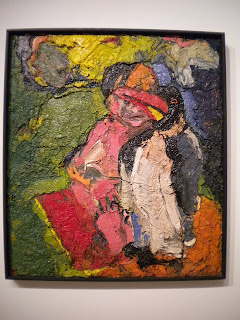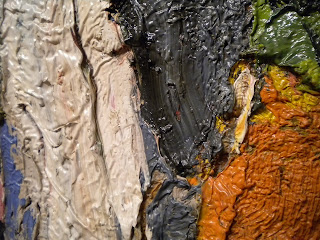Here is a "note" I posted on my FB wall and thought it would be a good add to my blog...


I apologize for the lack of proper grammar and seemingly randomness of this, but it had to be written down somehow!
It seems that I constantly come back to the same question, “what is the importance of art?” You think I would know that answer seeing that I went to school to be an art teacher, but that is why I think I constantly ask that question. I know that when I teach art I am consistently going to have the battle of teenage attitude of being lethargic. “Why is this important?” “What benefit is it to me?” “Art is all just an emotional expression.” If its one thing I want my future students to walk away with is that art is not an (meaningless) emotional expression, but a well thought out process.
With the thought of eternity at the forefront of my mind I now have added to my reoccurring question- “how does art have an eternal impact?” Ugh- big stuff. I mean don’t all things with eternal impact have some highly spiritual act behind it? How does me teaching art to students have an eternal impact?
In my mind and heart I constantly battle with this idea that the “art world” is not secular. To me- over the years, art has become a secular world- but why do I think that? Because most famous artists have no belief in God, more so they rebel against what He stands for. Is it possible that art is not completely secular, but not completely Christian but somewhere in the middle? Or could it be people don’t realize that everything we do in art basically requires inspiration from something that has already existed- ahem- already existed….meaning something else CREATED it. I rest my case. Even art was affected by the fall- and what could have possibly been intended as a great act of worship turned into a selfish soapbox for starving artists.
Here is a list I have started that says what I believe art does:
Art forces you to really “see” something or examine something
Art allows you to problem solve in many different ways
Art visually stimulates the brain, mind, eye, and soul
Art catches your attention
Art forces you to “know the whole story” / the artists background- you must put things into context to “get it”
Art causes discomfort and joy
Art begs for a reaction/reflection
Art has reason behind its actions (more so the artist has their reasons- again not mindless)
Art has an understanding of the rules (of art) to legitimately break them (this is by no means encouraging people to break the rules, but more so emphasizing the point that there are “rules” in art, again not mindless)
I believe drawing is one of the most difficult skills in the world- you want to know why…because no one believes they can do it. You want to know why no one believes they can do it…they are not patient enough to learn how to draw and then do it! The basics of drawing are breaking what you are drawing down to its basics! Simple huh? For example, when I teach children how to draw animals- I have them draw each part of the animal as a square, circle, oval, rectangle…you get the idea. Placing all the shapes together then whalla forms the animal!
Drawing also is not an instant act of gratification. With the world we live in today- everything is instant- therefore the patience needed for the art of drawing is being lost. I understand wanting to get something right on the first time, but there is something in the act of trying, trying and trying again. An artist could work on one painting or drawing for weeks because they are continually re-creating and re-destroying the same image over and over again (good book: A Giacometti Portrait, it is all about this). Keep at it until its right or until you know it can go no further. I myself am loosing the patience for drawing. That disappoints and discourages me. To sit down and do a drawing takes great time and focus- oh how I need to be more disciplined in this area.
You want to learn to have more patience and not expect everything in an instant? Learn to draw.
Art is an eye opener to how to have relationships with people and the absolute need to clearly communicate. One project/class assignment in art gets a return of 30 completely different takes on the criteria. What does that tell you? Everyone thinks and perceives a little differently so not everyone is going to be on the same page as you- especially if you don’t learn to clearly communicate your thoughts and ideas!
Art and photography is a good statement you hear in a sermon or on the news or from some high up famous person. Something that really strikes you and makes you go, “hmm”, or at least make some physical act of noise that means- you were some how affected by what you just saw.
So as this thought process will always be continually growing for me- I challenge you, give art a chance. View it, critique it, make it.
**pictures personally taken at the SAM (Seattle Art Museum)






